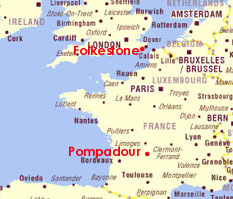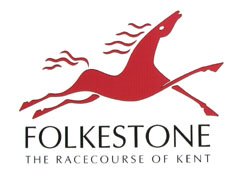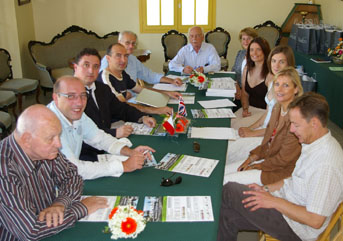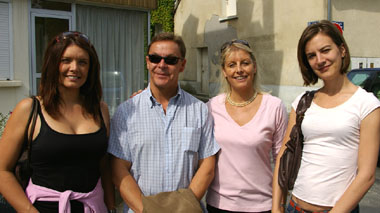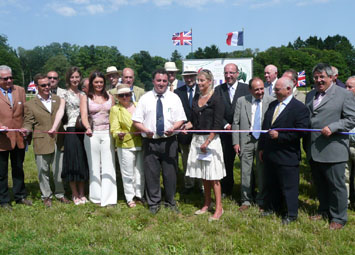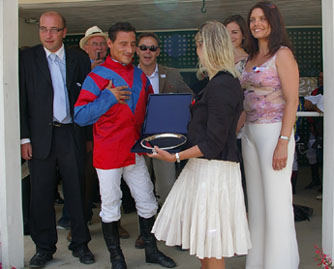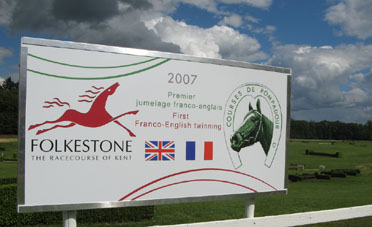Twinning Pompadour - Folkestone
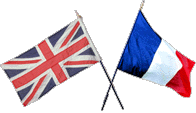
Since 2007 the Racecourses of Pompadour and Folkestone are officially twinned. This is a first, as to date no other similar agreement has taken place between racecourses in France and England. |
|
|
|
|
With a population of about 50,000 the town of Folkestone is in the County of Kent at the extreme south east of England, and only a stone’s throw from the major port of Dover (see adjacent map). It is also the British racecourse closest to France. |
|
|
|
The racecourse at Folkestone, like its counterpart of Pompadour, is dedicated to horse racing. This is why, Francis Delord , President of the Pompadour Horseracing Society, was quoted in the local press as saying ‘ Our two racecourses have comparable activities, with both offering flat and obstacle races. In addition with the influx of English residents in the region, of whom many are amateur riders, it is of interest to establish a relationship with a British counterpart’ |
|
And it was to seal a little closer this anglo-french relationship that a delegation from Folkestone was welcomed at Pompadour for the week-end of 14th July 2007. A formal meeting took place between the leading officials of the SCP in the salon of the Pavilion des Balances of the Pompadour racecourse. From left to right : Michel Jussiaux, Pierre Lachaud, Francis Delord, François-Xavier Duny, Christopher Lee, Jean Roux, Germaine Lacroix, Emma Santer, Rachel Patterson, Kate Hills and Duncan Flatt. |
|
|
Click to enlarge |
|
Alongside the delegation from Folkestone with from,left to right: Emma Santer Commercial Director the Folkestone racecourse), Duncan Flatt ( Technical Manager of Arena Leisure plc, the parent company who also own six other racecourses in England, namely, Doncaster, Lingfield Park, Royal Windsor, Southwell,, Wolverhampton, and Worcester), Kate Hills ( Head of Marketing and PR for the Racing Division of Arena Leisure), and Rachel Patterson ( an independent PR consultant working for Folkestone). |
|
|
Click to enlarge |
|
Everyone could be found at the Pompadour racecourse on Sunday 15th July for the third meeting of the season and the first for announcing the twinning. A commemorative panel was unveiled and a ceremonial tape cut by Francis Delord and Kate Hills between the third and fourth races in the afternoon. Many leading personalities were present including the sous-préfet of Brive, Mme Francine Prime ( standing to the right of Francis Delord in the photo), Jean-Michel Reillier, mayor of Pompadour and many of the mayors of the nearby communes. |
|
|
Click to enlarge |
|
The fourth race for the Colonel des Roches de Chassay Prize, was a steeplechase for horses of five or six years old. For this day this race was re-baptized as the Inauguration of the Twinning Folkestone-Pompadour Prize. Jacques Ricou won on Babytron trained by Guillaume Macaire. In the photo he is being presented with the prize by Kate Hills, watched by Pierre Lachaud, Jean-Michel Reillier, Duncan Flatt, Rachel Patterson and Emma Santer. Jacques Ricou, won two other races that afternoon and for the next race for the Prize of Corrèze and the Departmental Council he wore the colours of Georges Dauvergne, riding Monjean. |
|
|
Click to enlarge |
|
This weekend of the 14th July 2007 constituted a first successful stage of the twinning but it does not stop there. In fact a number of other initiatives are more or less launched. A delegation from Pompadour will travel to Kent at the beginning of December to attend a race meeting. Various other exchanges have been mooted, namely the horses of Pompadour being raced in Folkestone and vice-versa; several challenges will take place with a ‘Pompadour’ Prize established in Folkestone and a ‘Folkestone’ Prize in Pompadour. |
|
|
Click to enlarge |
| Several meetings will be arranged permitted all involved to know each other better, as the racing scene in Pompadour differs greatly from that across the Channel. However everyone is pleased with the establishment of this twinning with this objective of developing strong long-term links between the two parties. Francis Delord has said ‘This agreement will allow us to increase the value of the racing in each region, whilst helping those English who have moved to Limousin to discover our events, and to support equestrian, cultural, economic and agricultural exchange’. |
